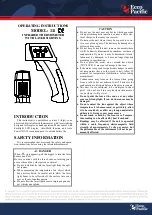
18
This device complies with the EU Directive 93/42/EEC con
cerning medical products, the Medizinproduktegesetz (Ger
man Medical Devices Act), the ASTM (American Society for
Testing and Materials) E 1965 98 and the European Standard
EN 124705: Clinical thermometers – Part 5: Requirements for
infrared ear thermometers (with maximum device) and the Eu
ropean Standard EN 6060112 (in accordance with CISPR 11,
IEC 6100042, IEC 6100043, IEC 6100048), and is sub
ject to particular precautions with regard to electromagnetic
compatibility.
Please note that portable and mobile HF communication systems
may interfere with this device.
3. Notes
Safety notes
WARNING
• To measure temperature, insert the sensor tip of the ear
thermometer carefully into the ear.
• Use of the ear thermometer on different persons can be inap
propriate in the event of certain acute infectious diseases be
cause of the possible spread of germs despite cleaning and
disinfection. If you have any doubts, please consult your doctor.
• The body temperature measured in the ear may differ from
other measurements taken in the mouth, rectum or armpits.
Any comparison of these values is therefore futile. Meas
ure temperature regularly to calculate the normal ear tem
perature and then use these measurements as a basis for
comparison when taking measurements in the event of a
suspected high temperature.
• This ear thermometer is intended for measuring the temper
ature in the ear. Do not use this ear thermometer for meas
urements in other parts of the body.
• Replace the protective cap after each use to ensure an accu
rate measurement and prevent crosscontamination.
• The ear thermometer may only be used with protective caps
from Beurer; other protective caps may result in faulty meas
urements. If you have run out of protective caps, contact the
manufacturer or retailer for replacements.
• Consult a doctor if you believe your medical condition to
be poor.
Notes on handling batteries
WARNING
• If your skin or eyes come into contact with battery fluid, rinse
the affected areas with water and seek medical assistance.
•
Choking hazard!
Small children may swallow and choke
on batteries. Store the batteries out of the reach of small
children.
• Observe the plus (+) and minus () polarity signs.
• If a battery has leaked, put on protective gloves and clean
the battery compartment with a dry cloth.
• Protect batteries from excessive heat.
•
Risk of explosion!
Never throw batteries into a fire.
• Do not charge or shortcircuit batteries.
















































